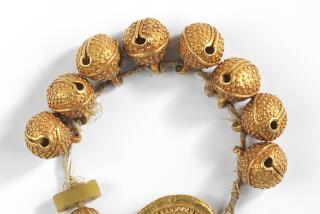âThe Art of the Stealâ wades into the move of the Barnes collection
Call it art appreciation as battle royal.
The emotionally charged new documentary âThe Art of the Steal: The Untold Story of the Barnes Collectionâ takes what might otherwise have remained a local matter of consequence only to art aficionados and blue bloods -- the decision to move a valuable art collection from an affluent Philadelphia suburb into the cityâs downtown area -- and presents the legal tussle and decades-spanning tug of war surrounding the holding as something decidedly else. Namely, âthe biggest act of cultural vandalism since World War IIâ as the film describes it.
âThe more I think about it, the more outraged I get,â said âArt of the Stealâ director Don Argott of his subject. âIf youâre not getting angry, youâre not paying attention.â
As such, the movie, which hits theaters Friday after having its L.A. premiere Tuesday at a sold-out Los Angeles County Museum of Art screening, plays out with all the bottom-line fixation and cloak-and-dagger intrigue of a corporate espionage flick. Early reviews have been mainly positive, with Entertainment Weekly praising the film as a âsuspenseful art-world documentary in which the forces of art and money collide ferociously.â
And since premiering at last yearâs Toronto International Film Festival, âStealâ has become a lightning rod for controversy, earning the condemnation of art world grandees, charity officials and most vocally, from the Barnes Foundation -- the very organization that the movie claims is being manipulated and exploited by a shadowy consortium of plutocrats and politicians -- for presenting a one-sided version of the dispute.
Barnes officials, who declined to be interviewed in the movie, have now taken issue with âSteal,â balking at the filmâs premise: That the decision to relocate the collection is tantamount to having it be âhijackedâ or âstolenâ in a Machiavellian power move that foils the Barnesâ original charter.
It gave Bret I. Miller, general counsel for the Barnes Foundation, cause to point out: âYou canât steal something from yourself.â
Chockablock with post-Impressionist and early Modern masterpieces by the likes of Van Gogh, Picasso, Degas and Renoir, the Barnes collection has been valued at more than $25 billion (although âpricelessâ is how itâs often described). Situated amid a 12-acre arboretum in Merion, Penn. -- and decidedly off the art tourism grid -- context is crucial to the collectionâs impact: Marquee works are displayed alongside distinctive arrangements with African sculptures, Pennsylvania Dutch furniture and Navajo rugs.
Argott, the Philadelphia-based documentarian behind âRock Schoolâ and âTwo Days in April,â presents a compelling argument, positing that the legal system was systematically gamed to get around visionary art patron Albert C. Barnesâ dying wishes.
A cantankerous outsider with a pharmaceutical fortune and an unmatched eye for masterworks, he began amassing art in 1912. Moreover, Barnes detested Philadelphiaâs blue bloods and resolved never to let his collection fall into the hands of local institutions.
So much so, he created an educational foundation to oversee its maintenance and drafted a seemingly ironclad will stating that his collection must never be lent, sold or moved. Before he died, the patron enlisted officials from Lincoln College, a private African American university, to serve as trustees.
And yet, as âStealâ exhaustively lays out via a series of impassioned talking head interviews that left many viewers on the documentary film circuit shaking with anger, after Barnesâ death in 1951, battle lines were drawn to challenge his will and legacy.
Some Barnes supporters dug in to keep the collection in place while other parties -- bureaucrats, charity officials and the very arts institutions the patron so despised -- strenuously worked to relocate the collection into the city.
Itâs a David and Goliath story with the might of organizations such as the Pew Charitable Trusts and the Philadelphia Museum of Art thrown into stark relief, depicted as strategically and legally outmaneuvering the Lincoln College trustees to defy the terms established in Barnesâ will.
(Pew officials declined to appear on camera in the movie and could not be reached for this article.)
The movieâs âa-haâ moments include former Philadelphia mayor (and current Pennsylvania governor) Edward G. Rendell admitting that the initiative to relocate the financially shaky Barnes collection came as part of a planned effort to create an international tourist draw for the city.
And in an uncompensated interview for the documentary, Times art critic Christopher Knight speaks about an explosive story he broke in 2006: how $107 million in state appropriations had been earmarked for the collectionâs relocation before a county court heard final arguments from a group challenging the move.
Despite it all, the collection is now scheduled to move to Philadelphiaâs museum-lined Benjamin Franklin Parkway as part of a $150-million public arts project in 2012. âTheyâre moving something that doesnât need to be moved five miles, spending a couple hundred million for no reason,â Argott exclaimed. âAnd theyâre using taxpayer money to do it.â
But according to several Barnes officials interviewed for this article, Miller, spokesman Andrew Stewart and executive director Derek Gillman, âStealâ is just sensationalizing a dispute between the foundation and a group called Friends of the Barnes that has already been settled in court.
Moreover, they cite a confidential e-mail that they say they intercepted from the filmmakers (which Barnes officials declined to discuss in detail) to argue that the production was biased from the outset, singling out âStealâ financier and executive producer Lenny Feinberg, a real estate investor and former Barnes Foundation student who they say has an ax to grind.
In an opinion piece for the Philadelphia Inquirer, Barnes Foundation Chairman Bernard C. Watson wrote on March 7: âThe filmâs narrative constructs a mosaic of villains and victims that, upon closer examination, collapses under the weight of unsubstantiated allegations of a âvast conspiracyâ to undermine the wishes of Dr. Barnes and âstealâ the collection. Indeed, the foundationâs initial concern that the film would lack objectivity and perspective has been more than borne out.â
Argott brushes off such criticism as too little too late. âWhen we approached them, they thought we were a small indie film that wasnât going to be seen by anyone. Now theyâre backed into a corner,â he said. âTheyâre saying the film is full of baseless facts and wild allegations. And yet they havenât given us any specific grievances to address.â
Further, the director denies that Feinberg set any agenda for the production. âLenny has a passionate interest with the place and as a collaborator, he was welcome,â Argott said. âWhether he had an agenda or not, we as filmmakers didnât.â
Gillman said that for whatever outcry âStealâ has generated, the film âis not going to have an impactâ on the collectionâs impending move.
âIn the last six months or so, membership has increased from just under 400 to almost 3,000,â Gillman pointed out. âThereâs a real momentum behind us. And the philanthropic community is very much behind the move.â
For his part, Argott says that he isnât out to change policy. He hopes the film will promote social advocacy.
âItâs an important, unfortunate story that touches on bigger themes than moving art,â Argott said. âItâs charity as big business and art versus commerce. As well as a personâs legacy: How safe is it? There are supposed to be checks and balances in our culture. In this instance, where everybody is on one side of an issue, nobody is holding feet to the fire and asking, âShould we be doing this?â â
More to Read
Only good movies
Get the Indie Focus newsletter, Mark Olsen's weekly guide to the world of cinema.
You may occasionally receive promotional content from the Los Angeles Times.











